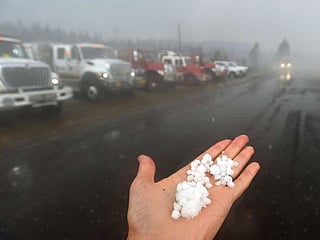Story of a tiny beautiful thing
It makes more sense to seek out daily causes for praise than daily reminders of lack

In Mississippi, power was out for days. In Alabama, schools opened late because of torrential rains. In Tennessee, houses slid from their foundations and tumbled into the Tennessee River. In Kentucky, heavy rains triggered a rock slide that derailed a train carrying ethanol, and the spilt fuel set the Big Sandy River on fire. All across the South this year, flooding has been nothing less than Shakespearean, even biblical, the kind of weather that comes from a human challenge to the divine order.
I don’t actually believe the Almighty dispenses weather to punish bad behaviour, but if I did, I’d have a good idea whose behaviour might have triggered it.
Paying attention to what is happening in Washington is a form of self-torment so reality altering that it should be regulated as a Schedule IV drug. I pay attention because that’s what responsible people do, but I sometimes wonder how much longer I can continue to follow the national news and not descend into a kind of despair that might as well be called madness. Already there are days when I’m one click away from becoming Lear on the heath, raging into the storm. There are days when it feels like the apocalypse is already here.
Except it isn’t, not really. Not yet. One day when the relentless rains let up for a bit, I went to the park an hour before sunset to walk on the muddy trails and take a break from the bad news. The woods were as lovely as they ever are after a rain: the creeks full of rushing water, the grey bark of the fallen trees slick with moss.
Above the trail, the limbs of the living trees creaked in the rising wind, the kind of sound that makes your heart ache for reasons too far beyond words to explain. Though the forest understorey is already beginning to green up, weeks too soon, the towhees scratching for insects stirring in what’s left of last fall’s leaves were not in any way sorry about the arrival of spring.
Also Read: Confessions of a hackneyed homeschooling mum
Also Read: COVID-19 kept me too busy mopping
Also Read: When cooking is an adult’s joy
Also Read: Masked men, and the paranoia of pandemics
Also Read: Slowly going crazy under lockdown
As darkness began to gather in earnest, I turned to head back the way I’d come. A few hundred yards on, my eyes caught on a tree I hadn’t noticed when I was walking in the other direction. About seven feet up the trunk was a knothole, a place where a limb had long ago broken off and let water in to rot the wood. Perhaps a woodpecker had helped to deepen it, too, and given the water more purchase over time.
The hole was small, a dark grotto in the thickly grooved bark of the stalwart oak, a hiding place that reached far into the mass of that old tree, and the failing light deepened its darkness. Who knows how many miniature woodland creatures have crept into its crevice over the years to nest, to shelter from the wind and rain, to hide from predators — or to wait for prey.
Natural greenhouse
But a creature lurking inside it is not what singled this knothole out among the hundreds, even thousands, I had passed on the path as night came on. What caught my eye was a cluster of tiny seedlings coloured the bright new green of springtime, so bright it seemed to glow in the gloaming. The tender plants were growing in the loam inside the knothole. Far above the ground, a hole made by decay in a living tree had become a cold frame, a natural greenhouse that lets in light and keeps out frost. Life in death in life.
In times like these, it makes more sense to seek out daily causes for praise than daily reminders of lack. So here is my resolution: to find as many ordinary miracles, as many resurrections as the seasons will allow. Tiny beautiful things are bursting forth in the darkest places, in the smallest nooks and deepest cracks of the hidden world, and I am going to keep looking every single day until I find one.
— Margaret Renkl is a contributing opinion writer who covers flora, fauna, politics and culture in the American South.
Sign up for the Daily Briefing
Get the latest news and updates straight to your inbox









